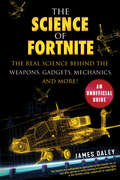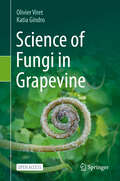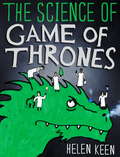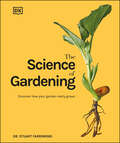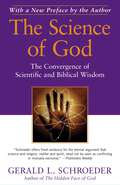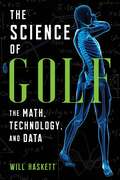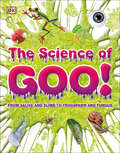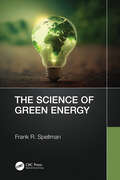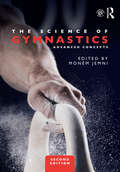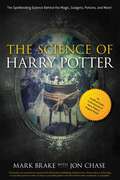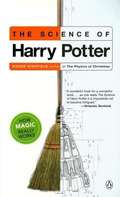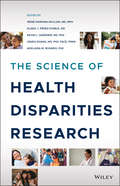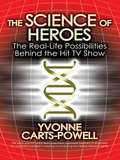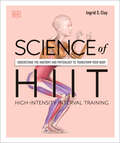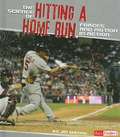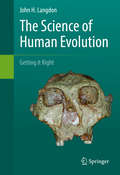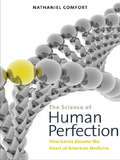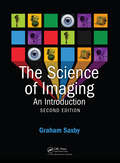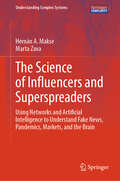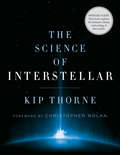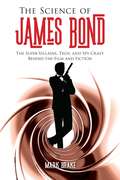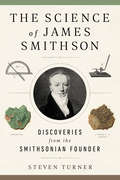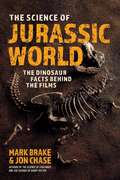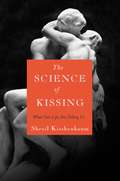- Table View
- List View
The Science of Fortnite: The Real Science Behind the Weapons, Gadgets, Mechanics, and More!
by James DaleyDiscover the science behind the Fortnite phenomenon! Drawing in more than a hundred million players in its first year of existence, Fortnite's crazy mix of intense combat, wild weapons, innovative construction mechanics, and eccentric environments has made it one of the most popular online video games in the world. A perfect gift for any Fortnite fan, The Science of Fortnite addresses more than fifty topics that span the entire Fortnite universe! This book includes scientific discussions of many of Fortnite&’s most interesting gameplay details, including: The islandThe battle busTrapsGadgetsWeaponsSchematicsBuildingThe storm This book will discuss how many of the game&’s most fantastical weapons might actually work, how the player-made structures would or wouldn&’t stand up to the stress of battle, and what the deal is with that huge purple storm! Whether you&’re a fan of Battle Royale, Save the World, or Creative play, The Science of Fortnite will entertain and enlighten you with the scientific truths behind this amazing game.
Science of Fungi in Grapevine
by Olivier Viret Katia GindroThis open access book provides a comprehensive exploration of the relationship between fungi and grapevines, covering contemporary mycological classifications, pathogens, the mycobiome, endophytes, and mycorrhizae. Inspired by the French book "La Vigne, Maladies Fongiques" by the same authors, which won first prize at the 2015 OIV book competition (Organisation Internationale de la Vigne et du Vin, Dijon), this work aims to extend and update that foundational text. The introduction delves into the origins and adaptability of grapevines in response to evolving fungal diseases, alongside an overview of their biology, epidemiology, and control measures. The second chapter covers the systematics of the genus Vitis, the developmental stages of the vine, the anatomy of various organs, the history and breeding of resistant varieties, and the natural defense mechanisms of grapevines against fungal infections. A significant portion of the book provides the latest insights into mycology, including chapters on fungal systematics and taxonomy, as well as the concepts of holobiome, microbiome, and mycobiome in relation to grapevines. The third part focuses on fungal diseases affecting green organs, wood, and roots, illustrated at macroscopic, microscopic, and ultrastructural levels, and includes discussions on disease cycles and epidemiology. Additionally, there is a chapter dedicated to grafting systems and the specificity of fungi in nurseries. The final chapter addresses the control of fungal diseases, from historical perspectives to modern chemical groups of active ingredients, natural fungicides, and comprehensive disease management strategies. This includes application techniques, calibration of spraying equipment, drift reduction, and proper storage and handling of fungicides. This open access book serves as a key reference on the complex interactions between fungi and grapevines for scientists, students, and winegrowers, offering extensive practical knowledge and a rich scientific background based on over thirteen years of research by the authors.
The Science of Game of Thrones: A myth-busting, mind-blowing, jaw-dropping and fun-filled expedition through the world of Game of Thrones
by Helen KeenA myth-busting, mind-blowing, jaw-dropping and fun-filled expedition through the world of Game of Thrones.Do dragons actually exist? Is it possible to crush a person's head with your bare hands?What really happened when royal families interbreed? How does wildfire win wars? Can you really kill someone with molten gold?Award-winning comedian and popular-science writer Helen Keen uncovers the astounding science behind the world's most popular television show. Join Helen as she sifts the fact from fantasy, discovers the truth beneath the togas, and reveals a world more fantastical than Daenerys Targaryen's wildest dreams. So pour yourself a bowl of brown, climb on your beast of burden, and prepare yourself for an amazing adventure. It's time to see the Seven Kingdoms as you have never seen them before.
The Science of Gardening: Discover How Your Garden Really Works
by Dr. Stuart FarrimondExploding myths and providing key takeaway advice for gardeners at any level, this book provides a shortcut to decades of gardening experience by explaining the science behind how a garden grows.How often should I water my plants? What&’s the most effective slug deterrent? Could I breed my own unique variety of flower? Do plants have intelligence? Does it really matter when and how I prune? And why is my compost heap so slimy? If you find yourself seeking the answers to these questions and many more, then this may be the book for you!The world of gardening can be a mystifying place, with so many instructions to follow and often little explanation as to why. Dr Stuart Farrimond casts his scientific eye over the garden to answer all the horticultural questions you&’ve ever wondered about.Get your gardening gloves on and dive straight in to discover:- An accessible guide structured around the life cycle of the garden, taking you from first shoots to pruning for renewal.- An accessible Q &A format, with stats and infographics to bring the story to life, as well as long-held gardening myths are exploded by new science.- Every way to greener fingers has action points so that you can understand the science, apply your gardening practice, and enjoy a flourishing garden.From hands-on, practical advice, to an exploration of the mental health benefits of gardening, whilst also covering topics such as the positive impact gardening can have on the earth during a time of climate crisis, The Science of Gardening debunks myths, and reveals the latest science often only taught at horticultural college. As a passionate newcomer to gardening, daunted by the mountain of often conflicting advice in gardening manuals, Dr Stuart Farrimond has set about testing the scientific basis of so much conventional wisdom and practice so you too can garden like a pro.A must-have gardening book for keen beginners with a passion for plants but who are daunted by the prospect of trawling through traditional gardening manuals for explanations, as well as experienced gardeners who are intrigued to find out the theory behind their practice and who want to improve on where they might be getting something wrong.At DK, we believe in the power of discovery. So why stop there? If you like Science of Gardening, then why try Science of Cooking or Science of Spice to complete the collection.
The Science of God: The Convergence of Scientific and Biblical Wisdom
by Gerald L. SchroederFor the readers of The Language of God, another instant classic from "a sophisticated and original scholar" (Kirkus Reviews) that disputes the idea that science is contrary to religion.In The Science of God, distinguished physicist and Biblical scholar Gerald L. Schroeder demonstrates the surprising parallels between a variety of Biblical teachings and the findings of biochemists, paleontologists, astrophysicists, and quantum physicists. In a brilliant and wide-ranging discussion of key topics that have divided science and religion--free will, the development of the universe, the origin of life, and the origin of man--Schroeder argues that the latest science and a close reading of the Bible are not just compatible but interdependent. This timely reissue of The Science of God features a brand-new preface by Schroeder and a compelling appendix that addresses the highly publicized experiment in 2008 in which scientists attempted to re-create the chemical composition of the cosmos immediately after the Big Bang. It also details Schroeder's lucid explanations of complex scientific and religious concepts, such as the theory of relativity, the passage of time, and the definitions of crucial Hebrew words in the Bible. Religious skeptics, Biblical literalists, scientists, students, and physicists alike will be riveted by Schroeder's remarkable contribution to the raging debate between science and religion.
The Science of Golf: The Math, Technology, and Data
by Will HaskettThe perfect gift for golf enthusiasts of all experience levels! InThe Science of Golf, seasoned sports broadcaster Will Haskett examines the science behind the beloved sport of golf. The author covers topics like the swing, the body, the mind, the equipment, the agronomy of the course, analytics, and much more. Haskett explains what makes the ball fly, how different swings can accomplish the same result, why different playing fields impact each shot, and how a rapid improvement in technology has made the sport easier and more accessible. With insight from industry experts, sports scientists, and some of golf&’s best minds, this book may surprise golf gurus and science geeks alike!
The Science of Goo!: From Saliva and Slime to Frogspawn and Fungus (DK 1,000 Amazing Facts)
by DKGet to grips with the glorious world of goop and gunk, from pus, snot, and mucus to mud, snail slime, and sticky plants, in this compendium of gunk.If you've ever wondered how much snot you make, or how spider silk is made, this is the book for you. Full of strange but true science, The Science of Goo! explores all manner of gunge, sludge, ooze, and goo! Awesome CGI illustrations and stunning photography will show goo in all its glory, while fun trivia and scientific explanations will make you an expert in all things sludgy. For example, did you know that sea cucumbers can vomit their sticky insides when threatened, yet still survive? The Science of Goo! is here to give you a new appreciation of the weird and wonderful world of gooey matter, in all its many kinds and wherever it shows up.
The Science of Green Energy
by Frank R. SpellmanConcern for the environment and the impacts of pollution have brought about the need to shift from the use and reliance on hydrocarbons to energy-power sources that are pollution neutral or near pollution neutral or renewable. Moreover, the impact of 200 years of industrialization and surging population growth threatens to exceed the future supply of hydrocarbon power sources. Therefore, the implementation of green energy sources is surging. The Science of Green Energy presents technologies and techniques, as well as real-world usage of and operation of today’s green energy-based applications. This practical book is designed to be used as an information source for the general reader, or for a course in energy, chemistry or in renewable energy engineering fields where green energy is becoming a key player. It is intended to fill a wide gap of missing information in published texts dealing with the green energy revolution currently in progress; it specifically provides information involving the many different sources of energy.
The Science of Gymnastics: Advanced Concepts
by Monèm JemniThe Science of Gymnastics provides the most comprehensive and accessible introduction available to the fundamental physiological, biomechanical and psychological principles underpinning performance in artistic gymnastics. The second edition introduces three new sections: applied coaching, motor learning and injury prevention and safety, and features contributions from leading international sport scientists and gymnastics coaches and instructors. With case studies and review questions included in each chapter, the book examines every key aspect of gymnastic training and performance, including: physiological assessment diet and nutrition energetics kinetics and kinematics spatial orientation and motor control career transitions mental skills training and perception injury assessment and prevention, with clinical cases advanced case studies in rotations, vault approach and elastic technologies in gymnastics. A fully dedicated website provides a complete set of lecture material, including ready-to-use animated slides related to each chapter, and the answers to all review questions in the book. The book represents an important link between scientific theory and performance. As such, The Science of Gymnastics is essential reading for any student, researcher or coach with an interest in gymnastics, and useful applied reading for any student of sport science or sports coaching.
The Science of Hair Care
by Claude Bouillon John WilkinsonThe most comprehensive source on the subject, this Second Edition is completely revised and expanded to reveal the most recent advances, technologies, and trends in hair and hair care science-tracking the development of hair care products, the emergence of new regulatory practices, and the latest methods in product safety and efficacy assessment.
The Science of Harry Potter: The Spellbinding Science Behind the Magic, Gadgets, Potions, and More! (The Science of Series)
by Mark Brake Jon ChaseHow does magic in J. K. Rowling’s universe work? Finally, the scientific secrets are revealed!The story of the boy who lived has brought the idea of magic and sorcery into mainstream fruition more than any other book series in history. Modern muggle scientists have uncovered explanations to the seemingly impossible, including answers to such questions as: Will we ever see an invisibility cloak? How hazardous is a flying broomstick like the Nimbus 2000? How has medicine made powerful potions from peculiar plants? (Felix Felicis, anyone?) Can scientists ever demonstrate Wingardium Leviosa, or the flying power of a Golden Snitch? Is it possible to stupefy someone? And many more!Often perceived as a supernatural force, magic captivates and delights its audience because of its seeming ability to defy physics and logic. But did you ever wonder if science has any explanation for these fantastic feats? The Science of Harry Potter examines the scientific principles—behind some of your favorite characters, spells, items, scenes, and even games like Quidditch and Wizard’s Chess—from boy wizard Harry Potter’s world, providing in-depth analysis and scientific facts to support its theories. Author Mark Brake, whose The Science of Star Wars was a knockout success, has found the answers to satisfy the curious spirits of muggles everywhere…A perfect Harry Potter gift for anyone obsessed enough to stand in line to be the first to see Harry Potter and the Cursed Child or Fantastic Beasts and Where to Find Them, witches and wizards alike will be fascinated by the merging of this improbable realm and real science!
The Science of Harry Potter
by Roger HighfieldCan Fluffy the three-headed dog be explained by advances in molecular biology? Could the discovery of cosmic "gravity-shielding effects" unlock the secret to the Nimbus 2000 broomstick's ability to fly? Is the griffin really none other than the dinosaur Protoceratops? Roger Highfield, author of the critically acclaimed The Physics of Christmas, explores the fascinating links between magic and science to reveal that much of what strikes us as supremely strange in the Potter books can actually be explained by the conjurings of the scientific mind. This is the perfect guide for parents who want to teach their children science through their favorite adventures as well as for the millions of adult fans of the series intrigued by its marvels and mysteries.
The Science of Health Disparities Research
by Irene Dankwa-Mullan Eliseo J. Pérez-Stable Kevin L. Gardner Xinzhi Zhang Adelaida M. RosarioIntegrates the various disciplines of the science of health disparities in one comprehensive volume The Science of Health Disparities Research is an indispensable source of up-to-date information on clinical and translational health disparities science. Building upon the advances in health disparities research over the past decade, this authoritative volume informs policies and practices addressing the diseases, disorders, and gaps in health outcomes that are more prevalent in minority populations and socially disadvantaged communities. Contributions by recognized scholars and leaders in the field—featuring contemporary research, conceptual models, and a broad range of scientific perspectives—provide an interdisciplinary approach to reducing inequalities in population health, encouraging community engagement in the research process, and promoting social justice. In-depth chapters help readers better understand the specifics of minority health and health disparities while demonstrating the importance of advancing theory, refining measurement, improving investigative methods, and diversifying scientific research. In 26 chapters, the book examines topics including the etiology of health disparities research, the determinants of population health, research ethics, and research in African American, Asians, Latino, American Indian, and other vulnerable populations. Providing a unified framework on the principles and applications of the science of health disparities research, this important volume: Defines the field of health disparities science and suggests new directions in scholarship and research Explains basic definitions, principles, and concepts for identifying, understanding and addressing health disparities Provides guidance on both conducting health disparities research and translating the results Examines how social, historical and contemporary injustices may influence the health of racial and ethnic minorities Illustrates the increasing national and global importance of addressing health disparities Discusses population health training, capacity-building, and the transdisciplinary tools needed to advance health equity A significant contribution to the field, The Science of Health Disparities Research is an essential resource for students and basic and clinical researchers in genetics, population genetics, and public health, health care policymakers, and epidemiologists, medical students, and clinicians, particularly those working with minority, vulnerable, or underserved populations.
The Science of Heroes
by Yvonne Carts-PowellA fun, fact-filled examination of the science (or lack thereof) behind the hit television series Heroes. Ordinary people with extraordinary powers populate the world of the hit television show Heroes, where characters exhibit such abilities as flight, telepathy, tissue regeneration, prognostication, invisibility, and teleportation through space and time. The Science of Heroes explores these superpowers and many more through real-world research into the potential of human physical and mental capabilities. Citing the work of renowned scientists and engineers, Yvonne Carts-Powell reveals that even the least likely of powers has been studied?and in some cases, even developed. From the wonders found in nature and cutting-edge technological achievements to the latest discoveries in genetics and mutations, humanity might just possess the knowledge to achieve the extraordinary.
Science of HIIT: Understand the Anatomy and Physiology to Transform Your Body
by Ingrid S. ClayTrain your way to a leaner, stronger body in half the time or less!Get ready to break a serious sweat with this scientific guide to HIIT training! Discover everything you need to know to achieve the best results from your HIIT workouts by understanding the muscle action needed to perfect each exercise.Inside the pages of this fitness book, you&’ll explore the physiology of more than 90 essential HIIT exercises! It is packed with: • Specially commissioned CGI artworks depicting all the main HIIT resistance exercises — from burpees to plank jacks — and variations that add or reduce the challenge. • CGI artwork features color-coding to highlight how the muscles, ligaments and joints engage, stretch and relax to perform each exercise. • Training programs, tailored to different abilities and goals, provide suggested workouts with a progressive increase in challenges over weeks and months. • Easy-to-follow infographics help explain the hard science behind why HIIT training is so efficient, and what beneficial physical adaptations it can bring. High-intensity interval training is a fantastic way to lose weight and get strong by performing very short bursts of targeted exercise. Recent scientific research shows that HIIT is the most efficient form of exercise for raising fitness levels and increasing cardio-respiratory health. Science of HIIT reveals the facts to help you optimize the benefits of HITT to your body and mind.The clear CGI artwork details the mechanics of each exercise, correct body posture, the muscles involved and how they engage to perform movements. You&’ll also learn the knowledge and tools needed to be able to create your own bespoke workouts. This HIIT guide will completely transform your performance and help you smash your goals!DK Publishing&’s Science of series helps readers discover the research and scientific theories behind exercise and sport. It&’s perfect for training at home or the gym. Other sport science books in this series include Science of Yoga and Science of Strength Training.
The Science of Hitting a Home Run: Forces And Motion In Action (Action Science Ser.)
by Jim WhitingDescribes the science behind hitting a home run, including pitch types, different bats, and force
The Science of Human Evolution
by John H. LangdonThis textbook provides a collection of case studies in paleoanthropology demonstrating the method and limitations of science. These cases introduce the reader to various problems and illustrate how they have been addressed historically. The various topics selected represent important corrections in the field, some critical breakthroughs, models of good reasoning and experimental design, and important ideas emerging from normal science.
The Science of Human Perfection: How Genes Became the Heart of American Medicine
by Nathaniel ComfortAlmost daily we hear news stories, advertisements, and scientific reports promising that genetic medicine will make us live longer, enable doctors to identify and treat diseases before they harm us, and individualize our medical care. But surprisingly, a century ago eugenicists were making the same promises. This book traces the history of the promises of medical genetics and of the medical dimension of eugenics. While mindful of the benefits of genetic medicine, the book also considers social and ethical issues that cast troublesome shadows over these fields. Keeping his focus on America, Nathaniel Comfort introduces the community of scientists, physicians, and public health workers who have contributed to the development of medical genetics from the nineteenth century to today. He argues that medical genetics is closely related to eugenics, and indeed that the two cannot be fully understood separately. He also carefully examines how the desire to relieve suffering and to improve ourselves genetically, though noble, may be subverted. History makes clear that as patients and consumers we must take ownership of genetic medicine, using it intelligently, knowledgeably, and skeptically.
The Science of Imaging
by Graham SaxbyEdited and expanded to keep pace with the digital revolution, the new edition of this highly popular and critically acclaimed work provides a comprehensive exploration of imaging science. Brilliantly written and extensively illustrated, The Science of Imaging: An Introduction, Second Edition covers the fundamental laws of physics as well as the cut
The Science of Influencers and Superspreaders: Using Networks and Artificial Intelligence to Understand Fake News, Pandemics, Markets, and the Brain (Understanding Complex Systems)
by Hernán A. Makse Marta ZavaThis book explores the identification of influencers in complex networks, bridging theoretical approaches with practical applications across diverse fields. It examines interdisciplinary complex systems, including online social media, biological networks, brain networks, socioeconomic and financial systems, and ecosystems. The research presented aims to benefit scientists in relevant areas and inspire new scientific inquiries, potentially advancing the field of influencer identification. In this context, 'influencer' serves as an umbrella term for essential, core, or central nodes within any complex network. The book investigates various manifestations of influencers, such as key figures in social media, critical nodes in genetic and brain networks, keystone species in ecosystems, systemically important banks in financial markets, and disease superspreaders. These diverse scenarios are approached by mapping the influencer identification problem to challenges in physics or computer science. The book caters to readers at three distinct levels: 1. Those seeking mathematically rigorous theories of influencers will find Chapter 2 particularly valuable, as it delves into the mathematical foundations of influencer identification algorithms. Subsequent chapters explore the application of these theories across various disciplines. 2. Data scientists interested in implementing these algorithms in their research and practical work will find relevant information throughout the book. 3. Professionals in finance, marketing, politics, and social media, as well as readers curious about the intersection of big data, influencers, and AI, will gain insights into how these tools can enhance decision-making processes. These readers are encouraged to focus on the introduction and chapters most relevant to their fields, while briefly reviewing the more technical sections. By offering this multi-layered approach, the book aims to provide a comprehensive understanding of influencer identification in complex networks, from theoretical foundations to real-world applications across various domains.
The Science of Interstellar
by Kip ThorneA journey through the otherworldly science behind Christopher Nolan's highly anticipated film, Interstellar, from executive producer and theoretical physicist Kip Thorne.
The Science of James Bond: The Super-Villains, Tech, and Spy-Craft Behind the Film and Fiction (The Science of Series)
by Mark BrakeSpy-Fi Culture with a License to KillFrom Sean Connery to Daniel Craig, James Bond is the highest-grossing movie franchise of all time. Out-grossing Star Wars, Harry Potter, and the Marvel Cinematic Universe, the world&’s most iconic and international secret agent has a shelf life of almost six decades, from Dr. No to Spectre. As nuclear missile threats are replaced by a series of subtler threats in a globalized and digital world, Bond is with us still.In The Science of James Bond, we recognize the Bond franchise as a unique genre: spy-fi. A genre of film and fiction that fuses spy fiction with science fiction. We look at Bond&’s obsessions with super-villains, the future, and world domination or destruction. And we take a peek under the hood of trends in science and tech, often in the form of gadgets and spy devices in chapters such as:Goldfinger: Man Has Achieved Miracles in All Fields but Crime!You Only Live Twice: The Race to Conquer SpaceLive and Let Die: Full Throttle: Bond and the CarSkyfall: The Science of CyberterrorismAnd more!This is the only James Bond companion that looks at the film and fiction in such a spy-fi way, taking in weapon wizards, the chemistry of death, threads of nuclear paranoia, and Bond baddies&’ obsession with the master race!
The Science of James Smithson: Discoveries from the Smithsonian Founder
by Steven TurnerAccessible exploration of the noteworthy scientific career of James Smithson, who left his fortune to establish the Smithsonian Institution. James Smithson is best known as the founder of the Smithsonian Institution, but few people know his full and fascinating story. He was a widely respected chemist and mineralogist and a member of the Royal Society, but in 1865, his letters, collection of 10,000 minerals, and more than 200 unpublished papers were lost to a fire in the Smithsonian Castle. His scientific legacy was further written off as insignificant in an 1879 essay published through the Smithsonian fifty years after his death--a claim that author Steven Turner demonstrates is far from the truth.By providing scientific and intellectual context to his work, The Science of James Smithson is a comprehensive tribute to Smithson's contributions to his fields, including chemistry, mineralogy, and more. This detailed narrative illuminates Smithson and his quest for knowledge at a time when chemists still debated thing as basic as the nature of fire, and struggled to maintain their networks amid the ever-changing conditions of the French Revolution and the Napoleonic Wars.
The Science of Jurassic World: The Dinosaur Facts Behind the Films (The Science of)
by Mark Brake Jon ChaseA tale of some of the most amazing creatures ever to grace this tiny planet—unearth how the science fiction of the Jurassic World franchise inspired the evolution of dinosaur science. It all began in 1993. Jurassic Park was a movie landmark in the development of computer-generated imagery and animatronic visual effects. Jurassic Park became the highest-grossing movie of that year, and the highest-grossing film ever at the time, a record held until the 1997 release of Titanic. The field of dinosaur science has blossomed by leaps and bounds and branched out in recent years, in no small part to this iconic movie series. In The Science of Jurassic World, we experience the amazing story of the birth of the dinosaurs, how they evolved to world dominance, how some became gargantuan in size, how others grew wings and flew, and how the rest of them met an untimely end. Chapters include: How did Jurassic Park transform dinosaur science?Was Dr. Alan Grant&’s job a walk in the park?What&’s with the giant dinosaur poop?When will we clone dinosaurs?And so much more! Discover how some of cinema&’s most incredible creations do justice to the jaw-dropping evolution of these fantastic creatures.
The Science of Kissing: What Our Lips Are Telling Us
by Sheril KirshenbaumFrom a noted science journalist comes a wonderfully witty and fascinating exploration of how and why we kiss. When did humans begin to kiss? Why is kissing integral to some cultures and alien to others? Do good kissers make the best lovers? And is that expensive lip-plumping gloss worth it? Sheril Kirshenbaum, a biologist and science journalist, tackles these questions and more in THE SCIENCE OF KISSING. It's everything you always wanted to know about kissing but either haven't asked, couldn't find out, or didn't realize you should understand. The book is informed by the latest studies and theories, but Kirshenbaum's engaging voice gives the information a light touch. Topics range from the kind of kissing men like to do (as distinct from women) to what animals can teach us about the kiss to whether or not the true art of kissing was lost sometime in the Dark Ages. Drawing upon classical history, evolutionary biology, psychology, popular culture, and more, Kirshenbaum's winning book will appeal to romantics and armchair scientists alike.
